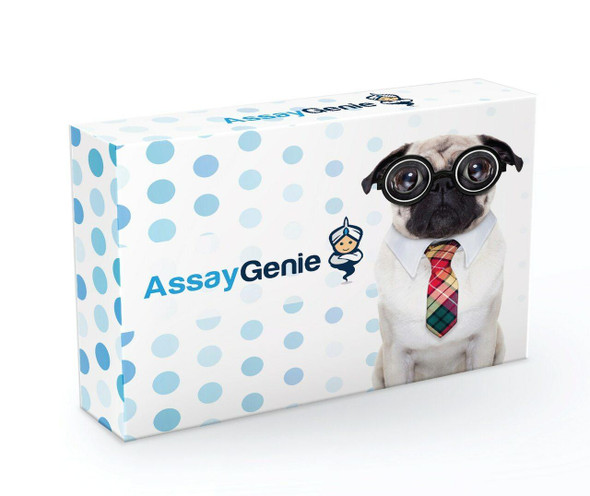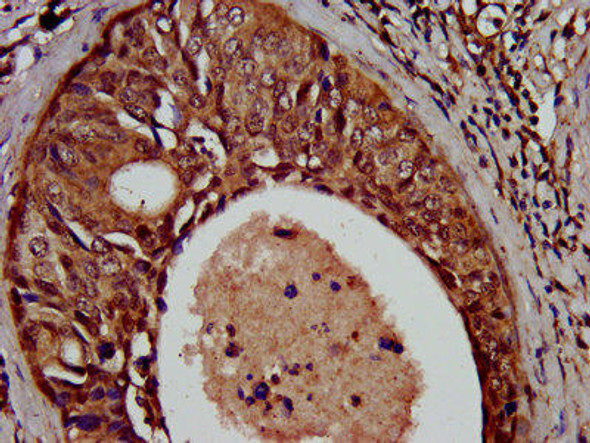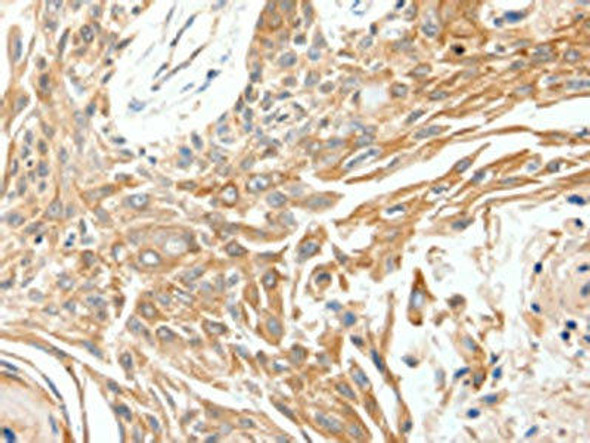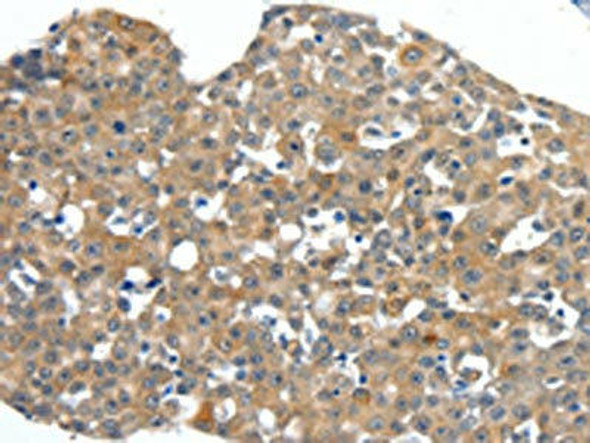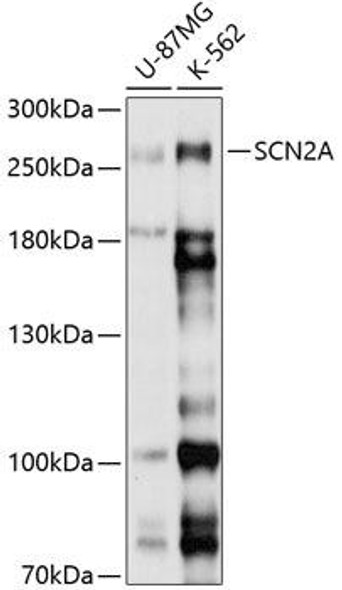Description
SCN1A/SCN2A/SCN3A/SCN4A/SCN5A/SCN8A/SCN10A/SCN11A Antibody (PACO01133)
The SCN1A, SCN2A, SCN3A, SCN4A, SCN5A, SCN8A, SCN10A, SCN11A Antibody (PACO01133) is a high-quality polyclonal antibody designed for research involving sodium channels, specifically targeting the mentioned SCN subtypes. These sodium channels play essential roles in regulating neuronal excitability and conduction in the central and peripheral nervous systems. Raised in rabbits, this antibody is highly specific and reactive with human samples, enabling accurate detection and analysis in various experimental applications, including Western blotting. By binding to the SCN1A, SCN2A, SCN3A, SCN4A, SCN5A, SCN8A, SCN10A, and SCN11A proteins, researchers can investigate the function and expression of these sodium channels in different cell types and tissues.
Understanding the role of SCN subtypes is crucial for unraveling their contributions to neurological disorders, such as epilepsy, autism, and pain syndromes. Through targeted research using this antibody, scientists can shed light on the mechanisms underlying these conditions and potentially identify novel therapeutic targets for their treatment.
| Antibody Name: | SCN1A/SCN2A/SCN3A/SCN4A/SCN5A/SCN8A/SCN10A/SCN11A Antibody |
| Antibody SKU: | PACO01133 |
| Size: | 50ug |
| Host Species: | Rabbit |
| Tested Applications: | ELISA, WB, IHC, IF |
| Recommended Dilutions: | WB:1:500-1:2000, IHC:1:100-1:300, IF:1:200-1:1000 |
| Species Reactivity: | Human, Mouse, Rat |
| Immunogen: | synthesized peptide derived from the Internal region of human Na+ CP-pan. |
| Form: | Liquid |
| Storage Buffer: | Liquid in PBS containing 50% glycerol, 0.5% BSA and 0.02% sodium azide. |
| Purification Method: | The antibody was affinity-purified from rabbit antiserum by affinity-chromatography using epitope-specific immunogen. |
| Clonality: | Polyclonal |
| Isotype: | IgG |
| Conjugate: | Non-conjugated |
| Synonyms: | SCN1A; NAC1; SCN1; Sodium channel protein type 1 subunit alpha; Sodium channel protein brain I subunit alpha; Sodium channel protein type I subunit alpha; Voltage-gated sodium channel subunit alpha Nav1.1; SCN2A; NAC2; SCN2A1; SCN2A2; Sodiu |
| UniProt Protein Function: | SCN1A: Mediates the voltage-dependent sodium ion permeability of excitable membranes. Assuming opened or closed conformations in response to the voltage difference across the membrane, the protein forms a sodium-selective channel through which Na(+) ions may pass in accordance with their electrochemical gradient. Defects in SCN1A are the cause of generalized epilepsy with febrile seizures plus type 2 (GEFS+2). Generalized epilepsy with febrile seizures-plus refers to a rare autosomal dominant, familial condition with incomplete penetrance and large intrafamilial variability. Patients display febrile seizures persisting sometimes beyond the age of 6 years and/or a variety of afebrile seizure types. GEFS+ is a disease combining febrile seizures, generalized seizures often precipitated by fever at age 6 years or more, and partial seizures, with a variable degree of severity. Defects in SCN1A are a cause of severe myoclonic epilepsy in infancy (SMEI); also called Dravet syndrome. SMEI is a rare disorder characterized by generalized tonic, clonic, and tonic-clonic seizures that are initially induced by fever and begin during the first year of life. Later, patients also manifest other seizure types, including absence, myoclonic, and simple and complex partial seizures. Psychomotor development delay is observed around the second year of life. SMEI is considered to be the most severe phenotype within the spectrum of generalized epilepsies with febrile seizures-plus. Defects in SCN1A are a cause of intractable childhood epilepsy with generalized tonic-clonic seizures (ICEGTC). ICEGTC is a disorder characterized by generalized tonic-clonic seizures beginning usually in infancy and induced by fever. Seizures are associated with subsequent mental decline, as well as ataxia or hypotonia. ICEGTC is similar to SMEI, except for the absence of myoclonic seizures. Defects in SCN1A are the cause of familial hemiplegic migraine type 3 (FHM3). FHM3 is an autosomal dominant severe subtype of migraine with aura characterized by some degree of hemiparesis during the attacks. The episodes are associated with variable features of nausea, vomiting, photophobia, and phonophobia. Age at onset ranges from 6 to 15 years. FHM is occasionally associated with other neurologic symptoms such as cerebellar ataxia or epileptic seizures. A unique eye phenotype of elicited repetitive daily blindness has also been reported to be cosegregating with FHM in a single Swiss family. Defects in SCN1A are the cause of familial febrile convulsions type 3A (FEB3A); also known as familial febrile seizures 3. Febrile convulsions are seizures associated with febrile episodes in childhood without any evidence of intracranial infection or defined pathologic or traumatic cause. It is a common condition, affecting 2-5% of children aged 3 months to 5 years. The majority are simple febrile seizures (generally defined as generalized onset, single seizures with a duration of less than 30 minutes). Complex febrile seizures are characterized by focal onset, duration greater than 30 minutes, and/or more than one seizure in a 24 hour period. The likelihood of developing epilepsy following simple febrile seizures is low. Complex febrile seizures are associated with a moderately increased incidence of epilepsy. Belongs to the sodium channel (TC 1.A.1.10) family. Nav1.1/SCN1A subfamily. 2 isoforms of the human protein are produced by alternative splicing. |
| UniProt Protein Details: | Protein type:Channel, sodium; Membrane protein, multi-pass; Membrane protein, integral Chromosomal Location of Human Ortholog: 2q24.3 Cellular Component: cell soma; plasma membrane; T-tubule; voltage-gated sodium channel complex; Z disc Molecular Function:sodium ion binding; voltage-gated sodium channel activity Biological Process: action potential propagation; adult walking behavior; generation of action potential; neuromuscular process controlling posture; positive regulation of defense response to virus by host; regulation of postsynaptic membrane potential; sodium ion transport Disease: Epileptic Encephalopathy, Early Infantile, 6; Generalized Epilepsy With Febrile Seizures Plus, Type 2; Migraine, Familial Hemiplegic, 3 |
| NCBI Summary: | Voltage-dependent sodium channels are heteromeric complexes that regulate sodium exchange between intracellular and extracellular spaces and are essential for the generation and propagation of action potentials in muscle cells and neurons. Each sodium channel is composed of a large pore-forming, glycosylated alpha subunit and two smaller beta subunits. This gene encodes a sodium channel alpha subunit, which has four homologous domains, each of which contains six transmembrane regions. Allelic variants of this gene are associated with generalized epilepsy with febrile seizures and epileptic encephalopathy. Alternative splicing results in multiple transcript variants. The RefSeq Project has decided to create four representative RefSeq records. Three of the transcript variants are supported by experimental evidence and the fourth contains alternate 5' untranslated exons, the exact combination of which have not been experimentally confirmed for the full-length transcript. [provided by RefSeq, Oct 2015] |
| UniProt Code: | P35498 |
| NCBI GenInfo Identifier: | 260166633 |
| NCBI Gene ID: | 6323 |
| NCBI Accession: | NP_001159435.1 |
| UniProt Related Accession: | P35498 |
| Molecular Weight: | ~ 229kDa |
| NCBI Full Name: | sodium channel protein type 1 subunit alpha isoform 1 |
| NCBI Synonym Full Names: | sodium voltage-gated channel alpha subunit 1 |
| NCBI Official Symbol: | SCN1A |
| NCBI Official Synonym Symbols: | FEB3; FHM3; NAC1; SCN1; SMEI; EIEE6; FEB3A; HBSCI; GEFSP2; Nav1.1 |
| NCBI Protein Information: | sodium channel protein type 1 subunit alpha |
| UniProt Protein Name: | Sodium channel protein type 1 subunit alpha |
| UniProt Synonym Protein Names: | Sodium channel protein brain I subunit alpha; Sodium channel protein type I subunit alpha; Voltage-gated sodium channel subunit alpha Nav1.1 |
| Protein Family: | Staphylococcal complement inhibitor |
| UniProt Gene Name: | SCN1A |
| UniProt Entry Name: | SCN1A_HUMAN |


